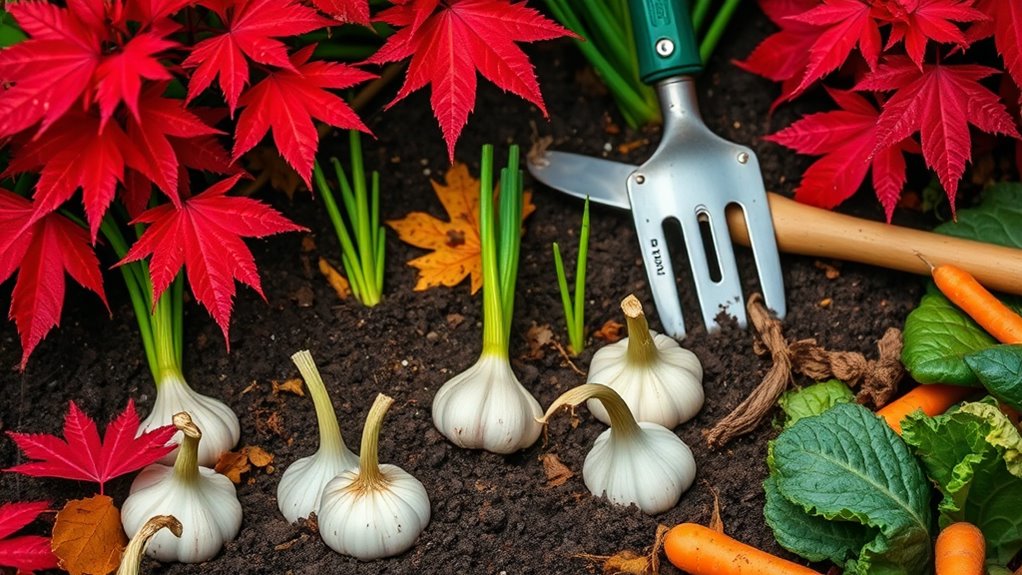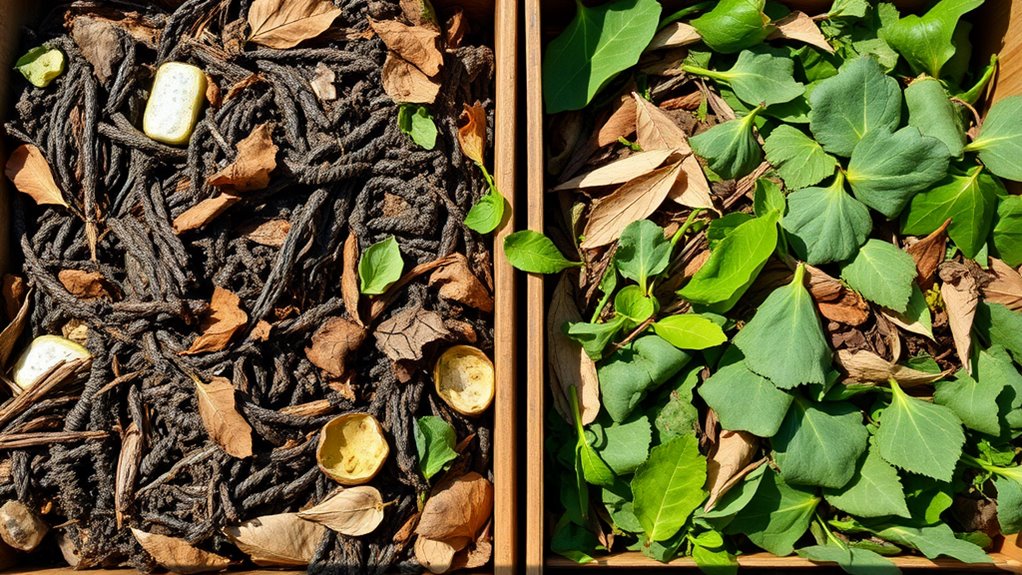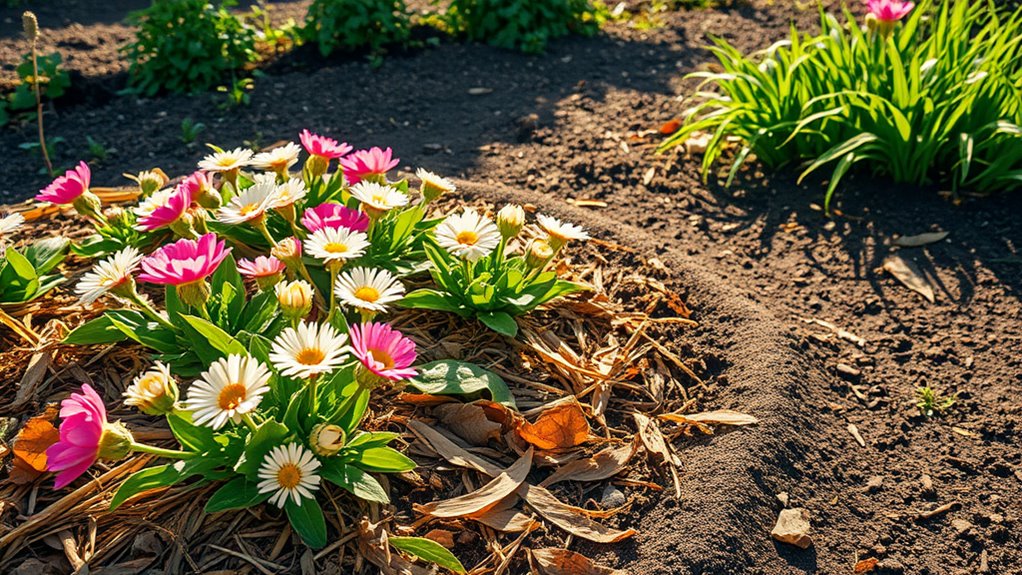Why Fall Is the BEST Time to Plant (And What to Grow)
Fall is the best time to plant because cooler temperatures let your plants absorb nutrients more effectively, build deeper roots, and dodge pests and weeds with less effort. You’ll thrive with hardy crops like kale, carrots, beets, and broccoli, which handle light frosts beautifully. Get ready for a bountiful harvest by prepping your soil and timing things right—explore these strategies for even greater garden success.
Key Takeaways
- Fall planting benefits from cooler temperatures, which enhance soil nutrient absorption and reduce plant stress.
- It allows for deeper root development before winter, leading to stronger, more resilient plants.
- Fewer pests and weeds in fall support healthier growth and higher yields for your garden.
- Top crops to grow include hardy vegetables like kale, spinach, carrots, beets, and radishes.
- Proper timing, based on local frost dates and soil temperatures of 50-60°F, ensures successful autumn harvests.
Benefits of Fall Planting
Fall planting offers several key advantages that can set your garden up for success. Moreover, fall’s cooler temperatures enhance soil conditions, promoting better nutrient absorption for robust plant growth.
You’ll establish plants with less heat stress, allowing roots to develop deeply before winter hits. This means you’re dodging peak pest seasons and giving perennials a strong start for spring blooms.
Incorporating fall gardening tips, like selecting frost-resistant varieties, maximizes growth potential while minimizing watering needs.
You’ll enjoy fewer weeds competing for resources, leading to a more vibrant garden next year.
It’s a practical, expert approach that boosts your yields with smarter timing and effort.
By following essential seasonal strategies, you can maintain a vibrant garden year-round.
Ideal Soil Conditions for Autumn
As you build on fall planting’s advantages, like deeper root growth, you’ll find that soil conditions play a key role in autumn success.
For optimal results, aim for well-drained soil that prevents waterlogging from seasonal rains, ensuring roots breathe easily. Incorporate organic matter, such as compost, to enhance fertility and structure, fostering beneficial microbes in cooler temperatures. Additionally, enrich your compost with kitchen scraps like vegetable peels and coffee grounds to further improve soil nutrients and sustainability.
Test and adjust pH to 6.0-7.0 for nutrient availability—use a simple kit for accuracy. Loosen the top 12 inches to reduce compaction, promoting better water infiltration and root expansion without excess effort.
Monitor moisture to keep it balanced, avoiding extremes that could stress plants.
To adapt these practices effectively, consider universal soil prep methods that accommodate various environmental conditions for consistent plant success.
Top Crops to Grow in Fall
With your soil prepped for autumn’s cooler days, you’ll want to focus on hardy crops that thrive in these conditions, such as kale, spinach, and carrots, which offer quick growth and frost resistance to extend your harvest season. Additionally, beginners should prioritize soil preparation to ensure optimal conditions for these fall plants.
Consider beets for their sweet, earthy flavor and easy storage; radishes provide a peppery crunch with rapid maturation.
Broccoli and Brussels sprouts deliver nutrient-packed yields, tolerating light frosts while building garden resilience.
Garlic and onions establish roots now for a robust spring harvest, maximizing your fall plantings’ potential in cooler weather.
For beginner gardeners, adding low-maintenance vegetables like lettuce and peas can simplify fall planting and yield effortless harvests.
Essential Tips for Successful Planting
To ensure your fall planting thrives, choose the right timing by checking local frost dates and aiming for soil temperatures around 50-60°F, as this sets the stage for strong root development.
You’ll maximize success by infusing emotion into your efforts, turning routine tasks into rewarding experiences.
-
Revel in the excitement of selecting hardy varieties that promise a harvest you’ll cherish.
-
Feel empowered by testing soil pH, unlocking your garden’s hidden potential for vibrant growth.
-
Savor the satisfaction of deep watering, nurturing roots that reward your dedication.
-
Embrace the joy of companion planting, creating a thriving ecosystem that connects you to nature.
-
Anticipate the pride from regular weeding, safeguarding your plants for a fulfilling autumn bounty.
Before planting, remember that soil testing can enhance plant health, boost crop yields, and avoid expensive gardening errors.
To optimize your garden’s performance, consider interpreting results from a soil test to identify and fix any underlying problems.
Preparing Your Garden for the Season
Before you tackle fall planting, clear your garden of debris and weeds to create an optimal space for new growth.
Next, test your soil’s pH and nutrient levels to identify necessary amendments. Add compost or organic matter to enhance fertility and structure, fostering robust root systems. Additionally, incorporate backyard solutions like leaves and grass clippings to improve soil quality naturally.
Plan your layout carefully, positioning plants for maximum sunlight, drainage, and spacing to avoid overcrowding. Use sharp tools like a garden fork to turn soil efficiently without compaction.
Finally, apply mulch to retain moisture, suppress weeds, and protect roots from early frosts, ensuring a thriving season. Furthermore, mulch enhances garden vitality by providing improved soil health through better moisture retention and pest control.





